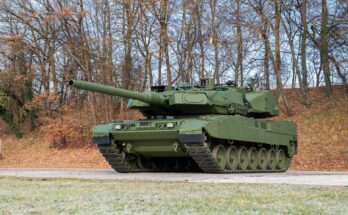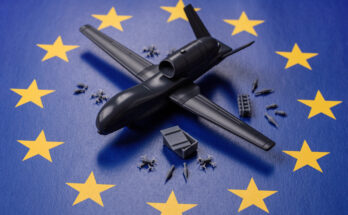By Derek Bisaccio, Military Markets Analyst, Forecast International.
With sanctions on Iran coming to a close thanks to the agreement between Tehran and the “P5+1” countries, international businesses are lining up to enter the Iranian market. President Hassan Rouhani’s recent visit to Europe – where he reached a number of high-profile agreements, including an order for 118 Airbus jetliners[i] – has been the subject of much fanfare, but Tehran is also seeking to build up its military capabilities.
Iran’s flashiest forthcoming military acquisition will be the S-300 air defense system, deliveries of which are scheduled for this month.[i] Alongside these systems, Iran will be looking to strengthen its force structures in order to keep up with its rivals in the Gulf, whose collective militaries dwarf Iran’s in terms of both expenditure and modern equipment.
One field that Tehran will be specifically addressing is its fleet of tanks. The most recent delivery of tanks took place over a decade ago, with both Russia and Belarus sending T-72M1s through 2001 and 2002, respectively. Beyond these and domestically manufactured variants, many of the tanks in service were delivered during the Shah’s rule, making them aged and potentially in poor combat shape.
In light of the situation with the military’s tanks, Tehran has started shopping for new acquisitions. Back in December, Iranian Brig. Gen. Ahmad Reza Pourdastan announced that Iran and Russia had been in talks regarding the T-90S tank. He added that in comparison to Iran’s T-72s, “the T-90 tank possesses better combat characteristics and meets all the requirements we set to the modern armor.”[ii]
Earlier this month, however, Pourdastan clarified Iran’s position, saying that Tehran was no longer interested in buying the T-90S from Moscow,[iii] but would potentially seek to acquire them through licensed production in Iran with assistance from manufacturer Uralvagonzavod. Pourdastan stated that Iran was perfectly capable of domestically producing an advanced tank comparable to the T-90S. Following Iran’s reversal, Alexey Zharich, the deputy director general of Uralvagonzavod, noted that the company would be willing to move forward with a licensed-production contract alongside Rosoboronexport, Russia’s arms export agency.[iv]
The desire to produce tanks domestically likely stems from Iran’s experience under sanctions and arms embargoes that have at times severely hampered Tehran’s ability to improve its military. Following the Shah’s overthrow and the Iran-Iraq War, international restrictions on Iran have forced the country to conduct repair and production work domestically, with mixed results.
Iran has domestically produced several tanks, such as the Zulfiqar line, but the abilities of these tanks are questionable, particularly when stacked up against either the modern tanks of its neighbors – Saudi Arabia’s M1A2 Abrams or Turkey’s Leopard 2s, for example – or the anti-tank systems in the hands of regional rivals and militant groups.
On February 9, Defense Minister Brigadier General Hossein Dehqan announced that Iran has already “designed and built [a] new battle tank from scratch” that is comparable to the T-90S, called the Karrar.[v] No further details of the Karrar have been released, and the timing of the announcement seems very sudden: presumably the tank would have been under development, at least, two months ago, when Iran was stating interest in the T-90S. If the Karrar was already being constructed – and as advanced as Dehqan insists – then Pourdastan would have had no reason to express interest in the T-90S at all.
Regardless, Iran’s answer to its tank deficit, be it either licensed-production of the T-90S or the Karrar tank, may well still be inferior to the hardware of Iran’s regional rivals. Even so, newer-generation tanks are far better than what Iran currently possesses and, as evidenced by the T-90’s success in Syria against militants armed with BGM-71 TOWs,[vi] will give Iran greater ability to respond in the event extremist groups make a concerted effort to attack the country.[vii]
The biggest challenge for Tehran will be financing the procurement of tanks. Iran is unlocking its frozen assets, worth billions, but the country has a number of priorities to address in both the civilian and military spheres. Iran’s return to oil markets will put downward pressure on the price per barrel, meaning that Tehran will not get quite the revenue influx it may have been anticipating when it began negotiations to end sanctions back in 2013.
Given the need for revamping the tank fleet, Iran likely will move forward with acquiring the T-90S through licensed-production or a similar model, such as the Karrar. Should the Karrar already be designed and built, Iran may still seek to improve future variants with technical assistance from Russia. Financial pressure, however, may well limit the number of tanks that Iran acquires, at least for the immediate future.
[i] Times of Israel, “Russia reportedly to begin delivery of S-300 to Iran in coming weeks,” December 25, 2015. http://www.timesofisrael.com/russia-reportedly-to-begin-delivery-of-s-300-to-iran-in-coming-weeks/
[ii] Tass News Agency, “Iran confirms plans to buy Russia’s T-90 tanks,” December 16, 2015. http://tass.ru/en/defense/844466
[iii] Al-Defaiya, “Iran No Longer Interested in Buying T90 Battle Tank,” February 5, 2016. http://www.defaiya.com/news/Regional%20News/MENA/2016/02/05/iran-no-longer-interested-in-buying-t90-battle-tank
[iv] Tass News Agency, “Russia proposes to Iran to organize licensed production of Russian T-90S tanks,” February 3, 2016. http://tass.ru/en/defense/854186
[v] Fars News Agency, “DM: Iran to Test New Generation Emad Ballistic Missile, Builds Battle Tank Like Russian T-90,” February 10, 2016. http://en.farsnews.com/newstext.aspx?nn=13941121000287
[vi] Louisa Loveluck and Roland Oliphant, “Russia sends its most advanced tanks to Syria frontline,” The Telegraph, December 4, 2015. http://www.telegraph.co.uk/news/worldnews/europe/russia/12034237/Russia-sends-its-most-advanced-tanks-to-Syria-frontline.html
[vii] Abbas Qaidaari, “Is Iran worried about IS on its border?” Al-Monitor, June 5, 2015. http://www.al-monitor.com/pulse/originals/2015/06/islamic-state-iran-border.html
For 50 years, Forecast International intelligence reports have been the aerospace and defense industry standard for accurate research, analysis, and projections. Our experienced analysts compile, evaluate, and present accurate data for decision makers. FI's market research reports offer concise analysis of individual programs and identify market opportunities. Each report includes a program overview, detailed statistics, recent developments and a competitive analysis, culminating in production forecasts spanning 10 or 15 years. Let our market intelligence reports be a key part of reducing uncertainties and mastering your specific market and its growth potential. Find out more at www.forecastinternational.com




